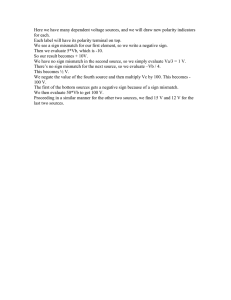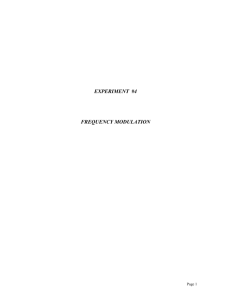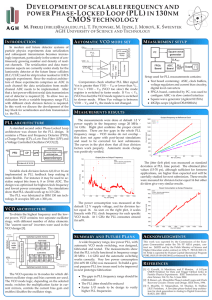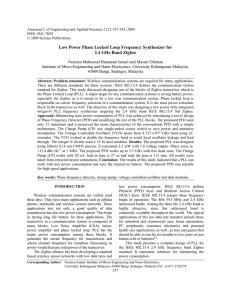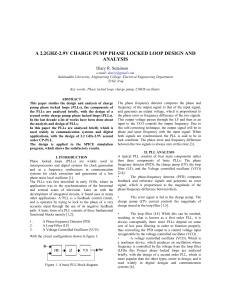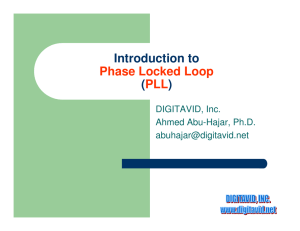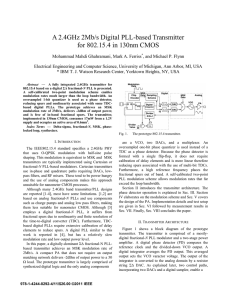Introduction to PLLs - UCLA Electrical Engineering
advertisement
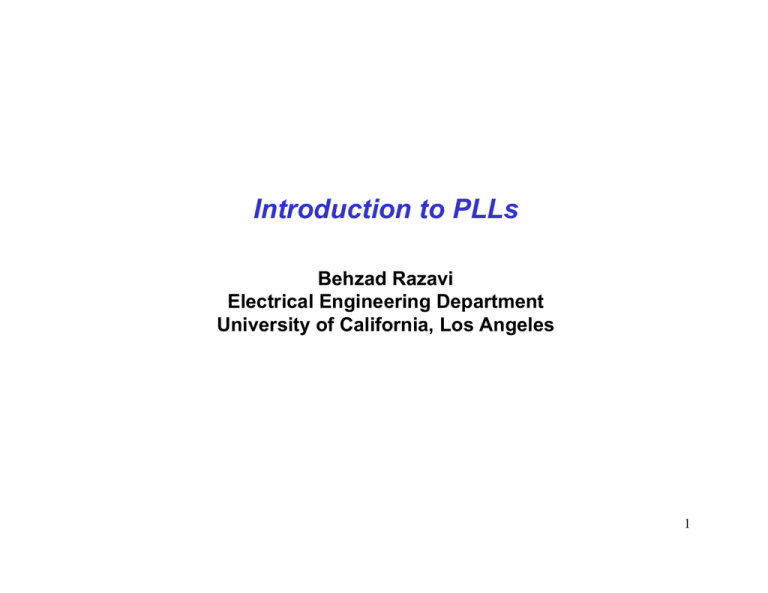
Introduction to PLLs Behzad Razavi Electrical Engineering Department University of California, Los Angeles 1 Outline z Need for Frequency Synthesis z Phase Detector z Type I and II PLLs z PFD/Charge Pump Nonidealities z PLL Design Procedure 2 The Need for RF Synthesis What happens if the LO freq is not exactly what we want? z z Need a freq. synthesizer: 3 Mathematical Model of VCO What happens if a small sine appears on Vcont? z 4 Phase Detector 5 Problem of Phase Alignment z Loop is locked if phase difference is constant. 6 Example z Ripple modulates VCO, producing sidebands. 7 Response to Frequency Step 8 Response to Phase Step 9 Phase and Frequency Settling 10 PLL Dynamics How do we compute the time or frequency response of a PLL? z 11 Type I PLL z z Trade-offs among stability, ripple, and phase offset Limited capture range Why is this better than a piece of wire? 12 z Frequency Multiplication Voltage Type z Phase or Freq Type How do these change for this type of loop: 13 Aided Acquisition 14 PFD Implementation z z Reset pulses are ~ 5 gate delays wide. Reset pulses are necessary to avoid “dead zone.” 15 PFD and Charge Pump Infinite gain yields zero phase offset. z Q A and QB are called “Up” and “Down” pulses, respectively. z 16 PFD/CP/Capacitor Behavior 17 First Attempt to Close the Loop 18 Type II (Charge-Pump) PLL 19 Frequency Multiplication Revisited 20 PFD/CP Nonidealities z z Skew between Up and Down Pulses Mismatch between Up and Down Currents z Charge Sharing z Channel-Length Modulation z Charge Injection Mismatch 21 Problem of Skew 22 Up and Down Current Mismatch z Produces both ripple and phase offset. 23 Channel-Length Modulation W/LN=10 um/60 nm Ix W/LN=20 um/120 nm Vx 24 Reduction of Channel-Length Modulation [Lee, Elec. Let., Nov. 00] [Terrovitis, ISSCC04] 25 Reduction of Both Mismatches [Wakayama, US Patent 7,057,465 B2] (Also, see Gierkink, ISSCC08] 26 Addition of Second Capacitor z z C2 can reach 0.2Cp with little degradation in settling behavior. But imposes an upper bound on Rp. 27 PLL Design Procedure z z Design VCO for frequency range of interest and obtain KVCO. Set the “loop bandwidth” to one-tenth of input frequency: (Loop BW ~ 2.5ωn for ζ = 1.) z z Select a charge pump current (tens of microamps to some milliamps). Set the damping factor to 1 and compute Rp and Cp. 28 Charge Pump Design z Select W/L of current sources for an overdrive of about 50-100 mV. z Choose L such that mismatch due to channel- length modulation remains below 10-20%. z Choose switch dimensions for a headroom consumption of 20-30 mV. z If mismatch due to channel-length modulation results in excessive jitter or sidebands: (a) Increase C2 and Cp (BW goes down). (b) Use one of the circuit techniques to reduce effect of channel-length modulation. Ip=0.5 mA KVCO=148 MHz/V 235 MHz 29 M=4 Simulated Behavior Rp=1.5 k Cp=25 p C2=5 p Rp=12 k Cp=25 p C2=5 p Rp=3 k Cp=25 p C2=5 p Rp=3 k Cp=25 p C2=2.5 p Rp=6 k Cp=25 p C2=5 p Rp=1.5 k Cp=25 p C2=2.5 p 30




